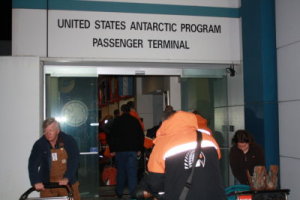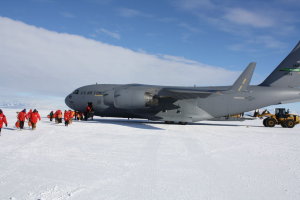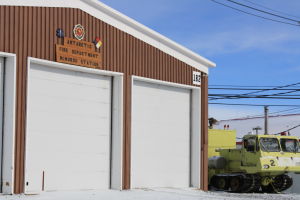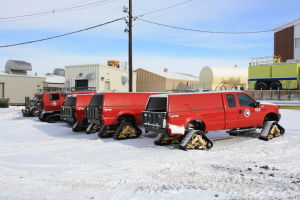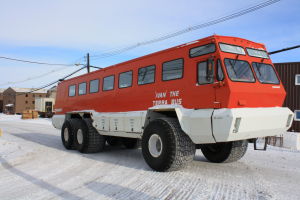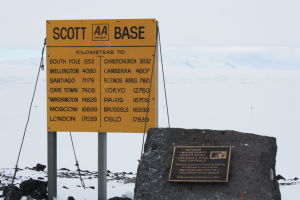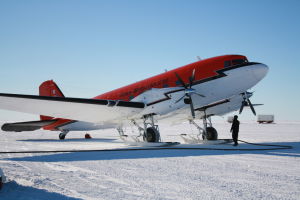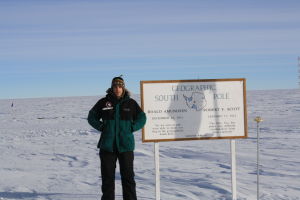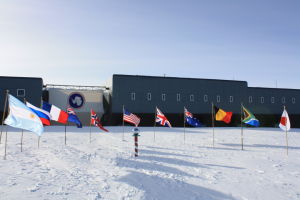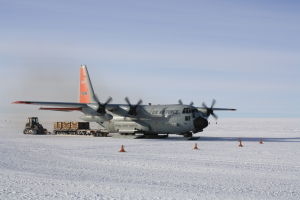All the fuel needed for the USAP bases (generators, vehicles) is airplane fuel. So every C-17 "Globemaster" (or C-130 "Hercules") flying from New Zealand has its fuel tanks completely full. Once on the ice, before heading back, it unloads just enough fuel to be able to make the return flight. Because those planes are designed to travel huge distances in one flight, it represents several tons of stocked fuel at each landing in Antarctica (1 or 2 per day during the 4-months summer season). This is just to explain that a fully loaded plan takes minutes and a surprisingly long distance to take off and to land.
But we finally made it, and broke the plane on landing, which implied no flights back for several days. There is goods and bads in this situation. The good is that no other people could come in (making sleeping, and finding its bunk-bed easier), the bad being the lack of supplies. This is what I saw when I first step out of the plane:
A little bus ride brought us to the McMurdo base, USAP biggest base on Antarctica. It is built to host more the 1000 people in the summer, and the winter crew is usually a total of 200 members. It is at the Southern top of an island, in the Ross Sea. This island is essentially made out of an active volcano (Mount Erebus, 3795 meters). I suppose this gives a good reference point from the Southern Pacific Ocean, and this is probably why Scott chose it as starting point for his race to the South Pole. To add a little historical touch to this website, let's just add that Scott (New Zealand) reached the Pole in early 1912, discovered that Amundsen (Norway) reached the pole 3 weeks earlier, and froze to death on his way back. Misfortune...
Here is a little anecdote for you all. The pole is at an altitude of 2835 meters, and because the atmosphere is much thinner at the poles than everywhere else, the physiological altitude your body experiences is about 3600 meters above sea level. According to the US workers regulation, this is considered as high altitude working conditions. So you are strongly advised to take the Acetazolamide (Diamox©) pills provided in Mcmurdo, starting the day before your flight to Pole and for the time needed for your body to acclimatize. As I spent more than a week in McMurdo due to bad weather conditions, I took those pills for more than a week, because I kept being scheduled on the next day's flight. The most interesting side effect of Diamox© is its tendency to mess up completely your taste, especially for carbonated drinks. So believe it or not, it kept me away from drinking beer for more than 2 weeks, which (as most of you know) would have been a kind of a challenge in my every day's life.
As I mentioned earlier, Sir Robert Falcon Scott came to Antarctica at the begin of the 20st century. He came twice, and used the little McMurdo Sound as his start base, essentially for stocking supplies. His hut is still completely intact and can be visited. The first amazing thing you see is a dead seal beside his hut. This thing has been around for almost hundred years and is still intact, nothing more, perhaps, than a little bit shrunk. Nothing disintegrates here, because of the cold and the dryness. And once you enter the hut, everything is still as Scott left it before he went to the pole and died on March 29th, 1912. Below are pictures of this hut, both outside and inside. I didn't post the dead seal on this site...
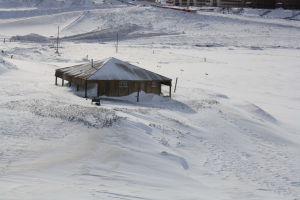
|

|
Another thing to see in the McMurdo area is the Scott base, property of New Zealand. I went there twice (little hike across the hills). It is much smaller than the McMurdo station. Their winter crew is about 20 people, but they have much better cold-weather fleeces in their store, and their beer is ways tastier.
On the 6th of November, the weather was nice both in McMurdo (McM) and at the South Pole (NPX) side. As I am in the summer and winter crew, I was allowed to take 140 pounds of luggage with me, but the plane I was about to board did not allow that much weight for one single individual. So I left most of my bags at McMurdo for a cargo flight scheduled the next week and I step in "Ivan the Terra" bus again to the runway.
Here is the deal: we were all scheduled to fly end of October, when the low temperatures do not allow C-130 "Hercules" planes to fly, due to military ratings. So I was scheduled on a DC-3 from 1934, retrofitted with turboprops, and rated to flight in temperatures as low as -55°C. Here is the plane : [like this one] out of the window, but unfortunately these do not give the same impression as out of a little plane above the most gorgeous place I have ever seen... Anyway, I landed on NPX air field (commonly called ski-way), and there I was, on the most remote place you can imagine to find a job, the geographic South Pole. A tradition here for the residents is to welcome the new-comers, so I got a warm hug from the next year's station manager, the doctor and the emergency rescuer I already met at Denver during the firefighter training.
And finally my luggage arrived as well, a few days later on a cargo flight because of the excellent weather conditions. These are the planes bringing supplies/people and discarding waste during the 3 and a half summer months at Pole.
